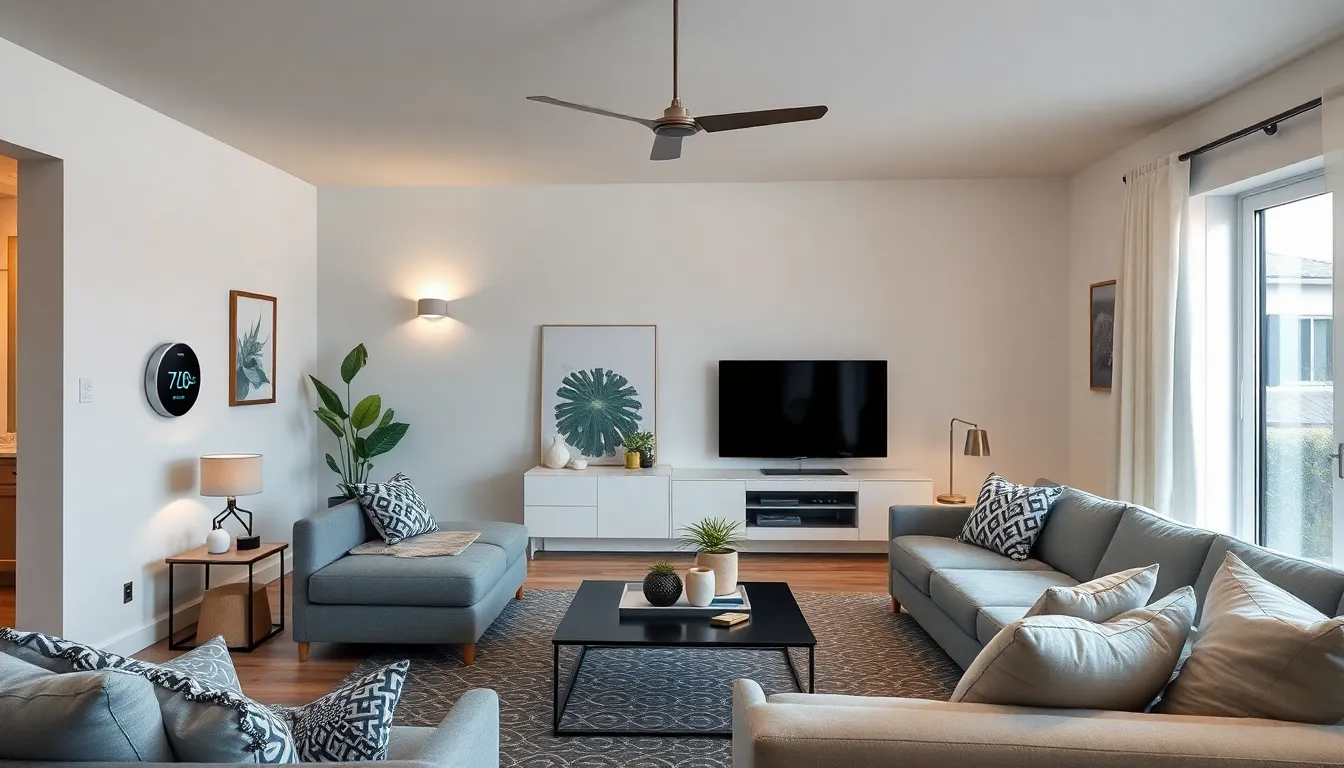Home automation promises a life of convenience, where lights dim at a whisper and coffee brews before you even open your eyes. But before you dive headfirst into the world of smart homes, hold your horses! The road to a fully automated paradise is riddled with challenges that can turn your dream into a tech nightmare faster than you can say “Wi-Fi connection.”
Table of Contents
ToggleOverview of Home Automation Challenges
Home automation encompasses various challenges that users face while striving for seamless integration of technology into their households. One significant challenge includes compatibility issues between different devices from multiple manufacturers. Many homeowners encounter frustration when attempting to connect smart appliances that do not adhere to common standards.
Security concerns represent another major challenge in home automation. Threats like hacking and unauthorized access can compromise privacy and safety. Keeping devices updated with the latest security protocols is crucial but often overlooked.
Installation complexity can also pose challenges. Some systems require professional installation, while others may be manageable for tech-savvy individuals. Users may need to invest time and effort in learning the intricacies of their chosen home automation systems.
Cost factors play a significant role in the adoption of home automation. Initial expenses can deter homeowners from fully committing to smart technology. Ongoing costs for subscriptions and potential upgrades further complicate financial considerations.
Maintenance is another critical aspect. Regular updates and troubleshooting can be time-consuming. Individuals might find themselves spending considerable time addressing issues instead of enjoying their automated lifestyle.
Interoperability can hinder the effectiveness of smart home setups. Devices from different ecosystems may fail to communicate, limiting functionality. Staying informed about product compatibility helps mitigate this challenge.
Lastly, a lack of standardization in home automation technologies creates uncertainty for consumers. With various protocols and platforms available, users may feel overwhelmed when selecting the right system. Awareness of current trends and developments in the home automation landscape aids in making informed decisions.
Technical Limitations

Various technical limitations can hinder the full realization of home automation’s benefits. Users often encounter issues that complicate their experiences.
Device Compatibility Issues
Compatibility challenges arise when integrating devices from different brands. Many manufacturers use proprietary technologies, resulting in products that don’t communicate effectively. This lack of standardization often frustrates users as they try to coordinate various systems. Some devices might require specific hubs or controllers, which adds to inconsistencies across smart home setups. Ensuring compatibility before purchase keeps future integration smooth. Researching product reviews and specifications provides insight into how well devices work together.
Connectivity Problems
Connectivity issues frequently disrupt the functionality of smart home devices. Wi-Fi signal strength plays a crucial role in maintaining seamless communication between devices. Weak signals can lead to delays or disconnects, impacting the user experience. Moreover, network congestion may hinder performance, particularly in homes with numerous connected devices. Users might need mesh Wi-Fi systems to bolster coverage. Regular updates to both firmware and software enhance device stability, reducing connectivity problems over time.
Security Concerns
Security challenges accompany the convenience of home automation. Users must prioritize their data privacy and protect devices from potential threats.
Data Privacy Risks
Data collected by smart home devices can include sensitive information. Personal preferences, daily routines, and behavioral patterns create privacy concerns. Using third-party services further heightens risks, as data may be shared without user consent. Misconfigurations in device settings can also expose personal information. Regularly reviewing security settings and understanding data management practices contributes to safeguarding privacy. Staying updated on privacy policies from manufacturers aids in making informed decisions about device usage.
Vulnerability to Hacking
Home automation systems are unfortunately attractive targets for hackers. Insecure devices or weak passwords facilitate unauthorized access. One significant concern involves unpatched vulnerabilities in device firmware, leaving networks exposed. Implementing strong, unique passwords reduces susceptibility. Users benefit from enabling multi-factor authentication when available. Regular security updates help protect devices from emerging threats. Deploying firewalls adds another layer of security against potential intrusions.
User Experience Challenges
User experience challenges in home automation can hinder the overall effectiveness of smart systems. Users often encounter significant complexities and a lack of standardization within their automated setups.
Complexity of Systems
Integration of various smart devices can create a complicated user experience. Many systems require advanced technical knowledge for installation and configuration. Some homeowners may find themselves overwhelmed by extensive options and settings. A user-friendly interface often becomes a priority, yet finding one can prove challenging. As a result, technical support may be necessary, which adds to costs. Simplicity in operation remains essential for user satisfaction.
Lack of Standardization
Home automation suffers from a notable lack of standardization among manufacturers. Various brands employ proprietary technologies, complicating interoperability between devices. Choosing products that promise compatibility involves significant research. Inconsistent communication protocols lead to difficulties in configuring systems smoothly. Users might require bridges or hubs to unify disparate devices successfully. Finding a standard that works across all products remains crucial for seamless integration. Prioritizing standardized solutions can enhance the overall reliability of home automation experiences.
Cost Implications
Cost implications significantly influence the decision to adopt home automation systems. Both initial setup and ongoing maintenance create financial considerations for homeowners.
Initial Setup Costs
Initial setup costs often present a considerable barrier to entry. Homeowners may face expenses ranging from smart light bulbs priced at $10 to whole-home systems totaling thousands. Smart security cameras typically range from $100 to $300 each, adding to the initial investment. Many systems require a hub or bridge that connects devices seamlessly, costing about $50 to $150. Integrating multiple devices can escalate the overall cost, necessitating careful budgeting. Additionally, professional installation fees typically range from $100 to $500, depending on complexity. Homeowners need to weigh the costs against their desired features before selecting devices.
Ongoing Maintenance Expenses
Ongoing maintenance expenses also affect home automation ownership. Monthly subscription fees for cloud services can range from $5 to $30, depending on the services utilized. Regular updates and troubleshooting demands contribute to ongoing costs and add time commitments. Moreover, smart devices occasionally require battery replacements or hardware upgrades that boost expenses. Even software incompatibility can surface, necessitating additional purchases to maintain a streamlined operation. Homeowners should plan for these recurring costs, prioritizing systems that balance functionality and affordability to enhance their automated experience.
Navigating the world of home automation presents both exciting possibilities and significant challenges. Homeowners must stay vigilant about compatibility issues and security risks while balancing costs and maintenance demands. The complexity of installation and the need for reliable connectivity can create hurdles that may discourage potential users.
By understanding these challenges and prioritizing informed decisions, individuals can enhance their home automation experience. Embracing standardized solutions and staying updated on trends will empower users to create a seamless and secure smart home environment. With the right approach, the journey into home automation can lead to a more convenient and enjoyable lifestyle.





